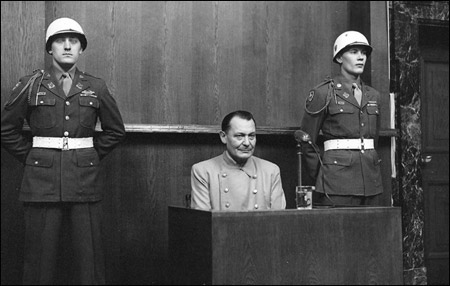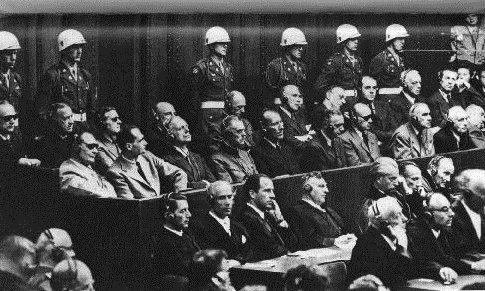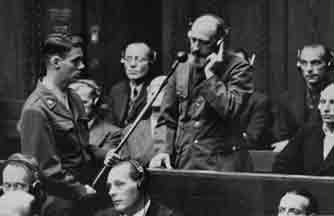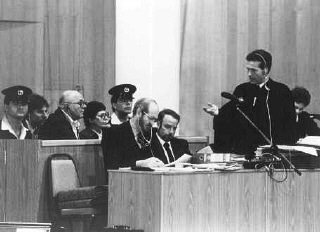Holocaust Education & Archive Research Team |
|
Trials Introduction to the Holocaust Trials
Trials
Interrogations & Testimonies
The IMT Series Nazi Justice
| |||||||||||||||||||||||||||||||||
The Holocaust on Trial
This page will focus generally on the major trials, and serve as an introduction to more detailed trial coverage. The first trial considered is that of former members of the SS staff of the Concentration Camp KZ Lublin/ Majdanek.KZ Lublin was an integral part of Aktion Reinhard as the clothing, shoes and other possessions were transported from the three Aktion Reinhard camps to the camp at the Old Airfield in Lublin, which came under the jurisdiction of KZ Lublin / Majdanek. In November 1944 a number of the KZ Lublin / Majdanek staff including Anton Thermes, Wilhem Gerstenmeier, Hermann Vogel , Theodor Schollen and two German Kapos, were tried before a Special Penal Court in Lublin. They were found guilty and were executed beside the camp crematorium on 3 December 1947.
A number of KZ Lublin / Majdanek personnel were also tried in the second Auschwitz trial in Cracow, the first trial being that of Rudolf Franz Ferdinand Höss in March 1947. Höss was tried, found guilty, and executed in the Auschwitz camp, beside the building of the former Commandant's office on 16 April 1947.
In the second Auschwitz trial there were 40 accused, including some former members of the SS staff at KZ Lublin: Artur Leibehenschel, Erich Muhsfeldt , Alice Orlowski, and Hildegard Lachert. The other principals tried were Hans Aumeier, Maximillian Graebner, Karl Ernst Mockel, Marie Mandl, Dr Johann Kremer, Therese Brandl and Dr Hans Munch. After a three week trial the sentences were announced on 22 December 1947; twenty three of the accused were sentenced to death, six to life imprisonment, the rest to various terms of confinement. Hans Munch was the only defendant acquitted.
The major war crimes trial was that held in Nürnberg, between 20 November 1945 and 31 August 1946, when a number of leading Nazi figures were tried for (1) the common plan, or conspiracy, (2) crimes against peace, (3) war crimes, and (4) crimes against humanity.The names of those who stood trial at Nürnberg and their sentences were :Karl Dönitz Commander of the German Navy 1943-1945 - 10 years (Prison)Hans Frank Governor of the GeneralGouvernement (Poland) - Death by hangingWhilhelm Frick Minister of the Interior - Death by hangingHans Fritzsche Head of the Radio Division of the Propaganda Ministry - AcquittedWalter Funk President of the Reichsbank - Life imprisonmentHerman Göring Head of the Luftwaffe - Suicide
Herman Göring committed suicide in his cell.Between 1947 and 1949 further trials were held at Nürnberg, covering the WVHA, IG Farben, Einsatzgruppen Doctors and others. The principal war criminals executed were Paul Blobel (Einsatzgruppen), Rudolf Brandt (Himmler's adjutant), Erich Nauman, and Otto Ohlendorf ( both Einsatzgruppen) and Oswald Pohl (Head of WVHA).
Various trials were held in the 1950's for lesser known functionaries, but following his capture and abduction to Israel from Argentina, the trial of Adolf Eichmann was a major event. He was condemned to death in December 1961, following his trial in Jerusalem and was executed on 31 May 1962.In terms of Aktion Reinhard, the systematic murder of Polish Jewry, the wheels of justice turned very slowly indeed. Some individuals were tried, such as Sepp Hirtreiter from Treblinka, who on 3 March 1951 was found guilty of war crimes, and sentenced to life imprisonment. Erich Bauer and Hubert Gomerski from the death camp at Sobibor were both tried and found guilty in 1950; both were sentenced to life imprisonment.Nine former guards at the Belzec death camp were brought to trial in München in 1963; eight were acquitted, and one, Josef Oberhauser, was found guilty and sentenced to four and a half years imprisonment.The next Aktion Reinhard trial was held in Dusseldorf in 1964/65. Those charged were personnel who had served in the Treblinka death camp. Fritz Kuttner died before the trial commenced but other former camp guards took the stand, and were given various sentences, from life to a few years in prison. Kurt Franz, Artur Matthes, Willy Mentz, August Miete, received life imprisonment , whilst Otto Horn was released.In September 1965 the Sobibor death camp trial started in Hagen. Twelve former members of the camp garrison stood trial. Karl Frenzel received life imprisonment, four others were given custodial sentences, six were acquitted, and Kurt Bolender committed suicide in his prison cell.In 1965 there was another trial of Auschwitz personnel held in Frankfurt/Maine. Twenty former camp staff, including Willhem Boger, Robert Mulka, Perry Broad, Franz Hofman, Oswald Kaduk, Josef Klehr, Dr Victor Capesius, Stefan Baretzki and others appeared before the court. Baretzki, Boger, Hofmann, Kaduk and Klehr received life sentences, whilst the others were sentenced to varying terms of imprisonment.Returning to Aktion Reinhard , the only living death camp commander, Franz Paul Stangl , was arrested in Brazil on 28 February 1967, and extradited to the then West Germany.The Second Treblinka trial commenced on 13 May 1967 in Dusseldorf and on 22 July 1970 Stangl was sentenced to life imprisonment for co-responsibility in the murder of 900,000 people during the time he was Commandant of the Treblinka death camp.Stangl died in Dusseldorf prison on 28 June 1971 whilst awaiting the outcome of his appeal against the sentence. The trial against Ernst Lerch in 1972, Globocnik's adjutant whilst Globocnik was SSPF Lublin, demonstrated that trials some thirty years after the event were fraught with danger; the proceedings were abandoned.The last major Holocaust related trial was that between the State of Israel and John Demanjuk in 1987. Demanjuk was accused of being "Ivan the Terrible", the gas chamber operative at the Treblinka death camp. He was found guilty on 18 April 1988, and was sentenced to death on 25 April 1988.Following a successful appeal he was released, as the death camp guard at Treblinka, was one Ivan Marchenko. However, it should be duly noted that there was conclusive proof that Demanjuk had been a guard in the Sobibor death camp.Sources:Alexander Donat . The Death Camp Treblinka. Holocaust Library New York 1979.Gerald Reitlinger, The Final Solution, South Brunswick, New York, Thomas Yoseloff 1961 Bernd Naumann , Auschwitz , Pall Mall Press, London,1966 Interpress , Auschwitz, Interpress Publishers Warsaw 1985 Jozef Marszalek, Majdanek, Interpress Warsaw 1986
Copyright. SJ. H.E.A.R.T 2008
|




